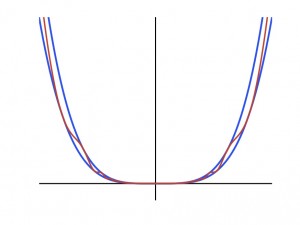The Squeeze Theorem
Let’s start with a statement of the squeeze theorem.
Theorem 1.1 Suppose \(g(x) \le f(x) \le h(x)\) and this is true for all \(x\) in a neighbourhood of \(x = a\) (except perhaps at \(x = a\)). Further, suppose \(\displaystyle \lim_{x \to a} g(x) = \displaystyle \lim_{x \to a} h(x) = L\). Then \(\displaystyle \lim_{x \to a} f(x) = L\).
The idea here is that \(f(x)\)is trapped (or squeezed) between\(g(x)\) and \(h(x)\).
Sometimes the squeeze theorem is referred to as the sandwich theorem since the limit is ‘sandwiched’ between two values.
This idea of squeezing the function between two other functions is illustrated in the following example.
Examples:
1. Evaluate \(\displaystyle \lim_{x \to 0} x^{2}f(x)\), where \(-3 \le f(x) \le 4\). Notice that \(-3x^2 \le x^2f(x) \le 4x^2\) so that the limit,\[\lim_{x \to 0} -3x^2 \le \lim_{x \to 0} x^2f(x) \le \lim_{x \to 0} 4x^2.\]Since the limit of both the left and right hand side equal zero, the function \(x^2f(x)\) is squeezed between zero and zero. Therefore the limit is zero!
2. Determine \(\displaystyle \lim_{x \to 0} x^4\left[6 + \sin\left(\frac{3}{x^2}\right)\right]\).
Knowing \(-1 \le \sin x \le 1\), one has \(-1 \le \sin\displaystyle\left(\frac{3}{x^2}\right) \le 1\) so that \(5 \le 6 + \sin\left(\frac{3}{x^{2}}\right) \le 7\) or $$5x^4 \le x^4 \left[6 + \sin\left(\frac{3}{x^{2}}\right)\right] \le 7x^4.$$Taking the limit,$$
\displaystyle \lim_{x \to 0}5x^4 \le
\lim_{x \to 0}x^4\left[6 + \sin\left(\frac{3}{x^{2}}\right)\right] \le
\lim_{x \to 0}7x^4.$$The limit of the left hand and right hand side are both zero, the initial function is squeezed in between zero and zero, forcing its limit to be zero as well.
3. Find \(\displaystyle \lim_{x\to\infty}\frac{\cos x}{x}\).
Since \(-1\le \cos x\le 1\), we have for \(x > 0\) that$$
-\frac{1}{x} \le \frac{\cos x}{x} \le \frac{1}{x}.$$By taking limits one has$$
-\lim_{x\to\infty} \frac{1}{x} \le
\lim_{x\to\infty} \frac{\cos x}{x} \le
\lim_{x\to\infty} \frac{1}{x}.
$$The limits of both the left and right hand sides is zero, so we have effectively squeezed the limit between zero and zero. Therefore, the desired limit must be zero!
